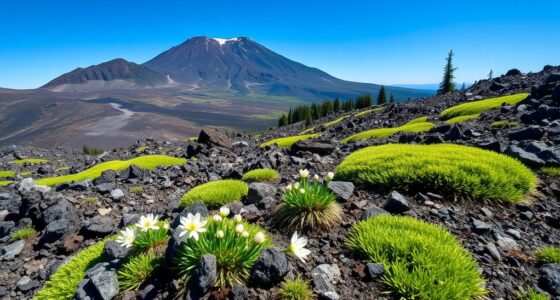You might think of wildfires as purely destructive, but they play a crucial role in maintaining healthy ecosystems. By clearing away dead vegetation and controlling pests, fires trigger natural renewal processes that benefit plant growth and habitat diversity. Understanding how fire contributes to ecological balance reveals a surprising side to these often feared events. There’s more to wildfires than meets the eye—discover how they support nature’s resilience and ongoing renewal.
Natural Fire Cycles and Ecosystem Balance
Many ecosystems rely on natural fire cycles to maintain their health and balance. When a fire occurs, it clears out dead plant material and makes room for new growth. This process prevents overgrowth, which can choke out younger plants and reduce biodiversity. Fires also release nutrients locked in old vegetation back into the soil, enriching it for future plants. Inspirational quotes about fatherhood serve to highlight the importance of nurturing and support, much like how fire rejuvenates an ecosystem. Many tree species, like pines, have adapted to require fire to open their cones and disperse seeds. Without these natural fires, ecosystems risk becoming crowded, less diverse, and less resilient. Fire acts as a reset button, promoting a dynamic equilibrium that sustains a variety of plants and animals. Recognizing this role helps us understand fire not just as destruction, but as a vital part of ecological health.
How Wildfires Promote Plant Regeneration
Wildfires play a crucial role in promoting plant regeneration by clearing away old and dead vegetation, which creates space for new growth. This process removes competition for nutrients, water, and sunlight, giving young plants a better chance to thrive. Additionally, many retail stores like Kroger Liquor Store Hours extend their hours during the holiday season to accommodate increased demand, which can help communities access necessary supplies after a wildfire. Many plants have adapted to fire-prone environments, developing mechanisms like fire-activated seed release or fire-resistant bark to survive and reproduce after a blaze. The intense heat can also crack open seed coats, making germination easier. Additionally, wildfires often enrich the soil with ash, adding essential nutrients that boost plant growth. As a result, fire-damaged areas quickly become fertile ground for a diverse array of plant species, fostering a vibrant, resilient ecosystem that continually renews itself.
Wildfires and Habitat Diversity
Although often seen as destructive, wildfires actually enhance habitat diversity by creating a mosaic of different environmental conditions within a landscape. When a fire sweeps through an area, it clears out dense vegetation, allowing new plants to emerge and thrive. This process results in a patchwork of varying successional stages, from bare soil to mature growth.
As a consequence, different species—plants, insects, birds, and mammals—find niches suited to their needs. Fire also opens up canopy spaces, increasing light availability and encouraging the growth of diverse plant communities. Over time, this dynamic cycle fosters a rich variety of habitats, supporting greater biodiversity.
Far from just destruction, wildfires serve as a catalyst for creating complex, resilient ecosystems that benefit many species.
The Role of Fire in Controlling Disease and Pests
By shaping the landscape and influencing plant communities, wildfires also play a key role in managing disease and pest outbreaks. Fire helps reduce the buildup of pathogens and insects that can threaten plant health. Additionally, the natural process of fire-induced regeneration promotes the growth of healthy, resilient vegetation that is less susceptible to pests and diseases. When a wildfire sweeps through an area, it destroys infected plant material and disrupts pest habitats, preventing their populations from spiraling out of control. This natural clearing allows for healthier new growth and encourages biodiversity, which further stabilizes ecosystems against pests and diseases. Many pests and diseases rely on dense, aged vegetation to thrive; fire interrupts these cycles, keeping populations in check. By periodically resetting plant communities, wildfires act as a natural regulator, promoting resilient, disease-resistant ecosystems.
Managing Wildfires for Ecosystem Health
Managing wildfires for ecosystem health involves implementing strategies that reduce their destructive potential while preserving their ecological benefits. You can achieve this by conducting controlled burns to clear out dead vegetation, which decreases fuel and minimizes the risk of uncontrolled fires. Forsale 100 Creating defensible zones around communities helps protect lives and property without disrupting natural fire cycles. Monitoring fire patterns allows you to predict and manage outbreaks more effectively, ensuring fires serve their ecological roles. Restoring fire-adapted landscapes through reforestation and thinning helps maintain biodiversity and promotes healthy regeneration. Educating communities about the importance of fire in nature encourages support for responsible management practices.
Conclusion
By understanding and respecting wildfires, you see their vital role in nature’s renewal. When managed responsibly, wildfires clear dead material, boost plant growth, and create diverse habitats that support many species. They help control pests and diseases, strengthening ecosystem health. Embracing fire as a natural part of the environment allows you to appreciate its surprising benefits, fostering resilient, vibrant landscapes for generations to come.








